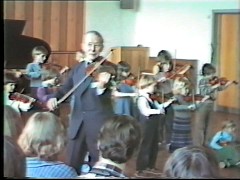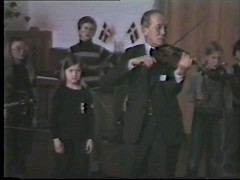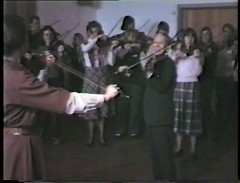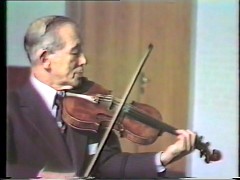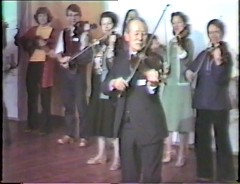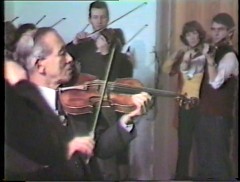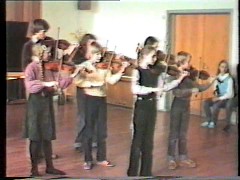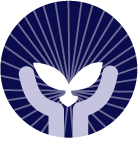Danish Suzuki Videos
The ISA thanks Claus Kanneworff for his invaluable assistance in making these videos available for the ISA Online Archive. His father, Per Kanneworff, provides the historical background for these rare live videos of Dr. Suzuki’s early teaching in Europe.
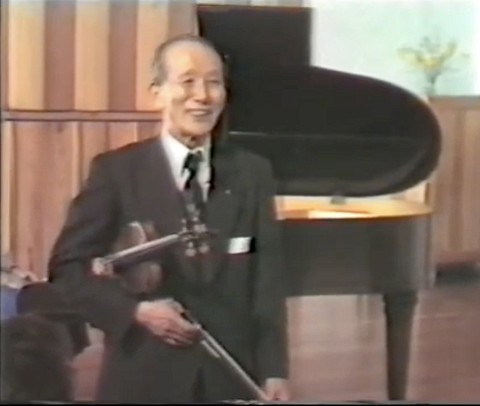
“In Easter 1981, the Danish Suzuki Institute held an international Suzuki workshop in Elsinore, Denmark. In this connection, Dr. Shinichi Suzuki was invited to give lessons.
The Director of the Danish Suzuki Institute, Mrs. Tove Detreköy, thought that we would have an opportunity to document Dr. Suzuki's work with the children. Having followed the system as a “Suzuki dad” through several years, I was asked by Mrs. Detreköy to make a video documentation of the lessons. At that time, I had no prior experience with filming, and later cut-and-paste and video editing. However, I was persuaded to try my best as Dr. Suzuki's visit probably would be the only chance for us.
We rented a VHS-video camera and a VHS-video recorder. During the lessons, we managed to make some twenty hours of camera recordings. Combined with our own VHS-video recorder we - that was Tove Detreköy, Béla Detreköy and I – copied and arranged the recordings into a relatively logical order with this very primitive equipment. Also, we filtered out and collected Dr. Suzuki's teaching points.”
Per Kanneworff
December 2024
The ISA would like to share the historical facts hidden within the story of how this footage came to be posted on the ISA website, thanks to the key figure involved: ESA Piano Teacher-Trainer Ruth Miura, currently residing in Barcelona, Spain. In her own words:
A History of the Danish Suzuki DVDs
I have been asked to give an account of how the Danish Suzuki DVDs from the 2nd European Suzuki workshop in 1981, filmed by Per Kanneworff and edited by Tove Detreköy, became available on the ISA website. It was a journey which took over 20 years, but I am truly happy and grateful to all those who were involved that these exceptional archive videos are now available for future generations of Suzuki teachers to watch.
Ruth Miura, Barcelona
27 October, 2025
A little background
Dr. Suzuki visited Europe over a period of more than ten years in order to teach children and train Suzuki teachers by his inspiringexample. I had previously met some of the Danish Suzuki students and teachers at the 1st Cambridge Suzuki workshop in 1980, but in 1981 I had not yet moved to London, and did not attend the 2nd European Suzuki workshop which was held in the International People’s College, a folk high school in Elsinore, from April 7th to 19th of the same year. It began with five days of teacher training, followed by a workshop for Danish Suzuki students, and a third children’s workshop for Suzuki students and teachers from ten European countries. (For a more complete report, see the ESA magazine).
From all accounts, this was an exceptionally happy and inspiring occasion for everyone, and to our great fortune, Dr. Suzuki allowed everything to be filmed at Tove Detreköy’s request. Years later, I learned that the resulting video material had been shared with another violin teacher trainer, who uploaded some excerpts on YouTube to illustrate certain basics of the Suzuki method.
Out of an abundance of caution (digital material was still in its early days in those years), the original videos had not been shown to anyone other than a few teachers, and this made me feel strongly that Dr. Suzuki’s teaching should be shared with all teachers in order to preserve his important legacy. To understand the true power of his teaching, watching an entire lesson gives a much better sense of continuity, and part of the learning process is seeing the progression from beginning to end.
From this point on, I spent over 16 years asking for access to the videos through sending annual Christmas cards, requesting in person at workshops within Europe, and later by sending email requests to ESA teachers who I hoped would be able to help. Dr. Suzuki’s example of never giving up probably made me a bit of a nuisance to some of my Suzuki colleagues- but I felt that it was important to get the videos transferred to DVD before they disintegrated with age (sadly, this had already happened to the old videos from another major ESA children’s workshop, and these films have been lost forever).
The trip to Denmark, February 26-28, 2011
As a last resort, I asked Tove Detreköy at a Suzuki event that if she could not release the videos, if she would allow me to come to Denmark and watch them, to which she kindly agreed. In exchange for this great privilege, I prepared a half day of audio-visual material which the TERI audio visual department had so generously shared with me over the years, and showed it to a small group of Danish teachers.
Tove and Bela sensei welcomed me with great warmth to the beautiful old house which was their ‘Suzuki lesson home’ for many years. As I climbed the wooden stairs, looking at all the photos of previous workshops, I felt that I could almost hear the echo of footsteps of the countless children who had begun their Suzuki studies in that wonderful place. I slept on a camp bed in Tove sensei’s studio, and spent two days watching stacks of VHS videos of the Elsinore workshop until the early hours of the morning, taking notes on all the contents for later reference. Violin teacher Marianne Rygner also came to watch some of the videos together with me, and I was deeply touched by the sense of complete trust and Suzuki companionship I felt by being allowed to spend a large part of those two days alone with such precious material. It was like seeing Dr. Suzuki in person again and feeling his great spirit.
The DVD pedagogical contents
These videos are an exceptional document, as Dr. Suzuki was in amazing form in 1981. His sense of humor, coupled with great clarity and high expectations, shone through in his work with both teachers and the small groups of students he taught. This even extended to the musical tempos he asked the pianist to follow! (See the Seitz Concerto on DVD 2, where he conducts the entire piano introduction).
I had never heard him playing so much before on other videos, and with such inner power. A sense of this can be felt on DVD 7 during one of the individual teachers’ lessons on the Handel D major Sonata, where he works on phrasing and a sense of prayerfulness, demonstrates by playing, and talks about how he can feel Handel’s spirit.
His humorous comments always had a core of truth, and were often used as a way of relaxing the intense concentration. To the teachers once: ‘We must say thank you to the horse – otherwise it would be impossible to play the violin!’ (without the horsehair). He was always resourceful- and once, when he found himself without enough chocolates to give out during a group lesson Tonalization exercise, one chocolate was carefully handed round to each person who played!
Don’t rush, but don’t stop (Dr. Suzuki, Nurtured by Love)
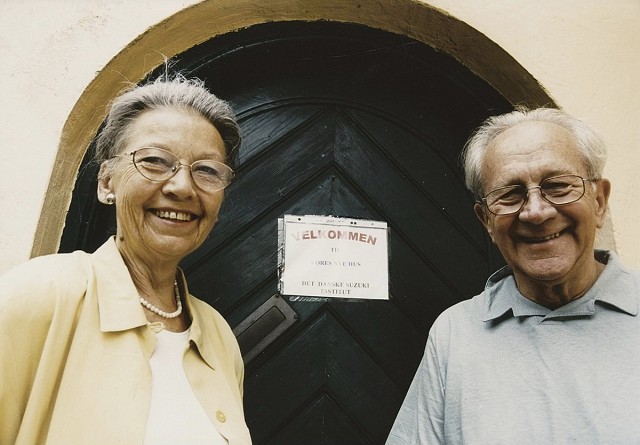
Tove & Bela Detreköy
At a Suzuki event later on that year in Germany where we happened to meet, Tove sensei told me, ‘Your troubles are over’, and explained that they had begun the arduous process of converting the videos to DVD format. Several years passed without any news, before I received an email from Marianne Rygner in 2015 telling me that due to Tove and Bela’s advanced age (they were both 90 that year), this project had been put on standby. I replied that I had not given up hope that one day it would be possible to make the DVDs available to all Suzuki teachers. This was a point on which we all agreed, but making it happen took longer than expected.
Things gradually began to move forward in a positive way. After meeting the DSI president and Suzuki violin teacher trainer Jan Matthiessen at the 70th Anniversary of Suzuki Method celebrations which were held in 2016 at the Colegio Montserrat in Barcelona, he told me he had learned that his Suzuki violin colleague Claus Kanneworff’s father Per had filmed the videos, and that eventually it would be possible to have copies made.
By February 2017, TERI Chairman Dr. Hayano had also asked me about other videos of Dr. Suzuki’s visits to Europe. He had learned of the existence of the Danish videos from Mitsuko Kawakami, who has always been of such great support to me during her years at the TERI office, and reiterated that Dr. Suzuki himself would have wanted them to be shared for teachers to learn from.
In February 2017, I received the best news of all – Jan wrote to tell me that he had received a complete set of the Elsinore DVDs from Claus sensei, and had been given permission to make copies for me. The idea was to upload them onto a private YouTube channel, with the condition that they were not to be sold commercially or altered in any way.
When another year went by without any news, I wrote again to ask about the DVDs. Technical problems in copying the videos were responsible for the delay, so it was indeed a very happy day when I finally received the physical copies from Jan sensei of DVDs 1-6 in June 2018. DVD 7 followed in digital form, and all the material was immediately copied onto an external hard drive (thanks go to guitar teacher trainer Mauro Bianco Levrin for his technical assistance). Since then, I have showed excerpts of the Elsinore lessons to many teachers on different occasions, and they are always awed and inspired by Dr. Suzuki’s life force and powerful teaching. To those who knew him, his use of English was picturesque at times, but always went straight to the point!
The last steps
Dr. Suzuki taught me over the years about the value of perseverance – and this was indeed the longest Suzuki project I have ever worked on. In October 2023, I gave a digital copy of all the Elsinore workshop videos to Dr. Hayano at the Teacher Trainer’s Convention in Matsumoto, as a thank-you for TERI’s great generosity in sharing their historical videos of Dr. Suzuki with me over the years. They have long been an invaluable way to show both new and experienced teachers excerpts from historical concerts, as well as Dr. Suzuki teaching and speaking on his philosophy.
Last month in October 2025, Dr. Hayano replied to one of my emails from 2023 to inform me that the DVDs had been posted on the ISA website in time for Dr. Suzuki’s birthday. I think this is a perfect way to ensure that the material will remain secure and unaltered. We are all very fortunate that Allen Lieb has worked so tirelessly over the past years to preserve the audio-visual legacy of Dr. Suzuki through the ISA video archives. I am extremely grateful to them both. I have never met Claus sensei or his father Per, but their great generosity in sharing these videos is a bright star in our Suzuki archives, and will continue to inspire generations of Suzuki teachers.
I would also like to extend my deepest thanks to all the Suzuki colleagues who made this end result possible, and thank them for their patience, especially to Suzuki violin teacher-trainer Jan Matthiessen, without whom I would never have experienced the joy of receiving a package of DVDS postmarked from Denmark.
Addendum
In 2011, I made a detailed summary of all the 7 DVDs which lists as far as possible all the repertoire performed in both the group and individual children’s and teachers’ sessions, with added comments on specific lessons and occasional clarification. (Available on the TERI Monthly Suzuki website.)
Summaries
Video 1: Books 1 & 2 - 2hrs 4min
Dr. Suzuki opens by sharing how his strong desire for all children to be educated and develop good character inspired the creation of the Suzuki Method, rooted in his philosophy of talent (or ability) education. He demonstrates foundational violin techniques, such as a good bow hold and left hand frame, before leading a series of group and individual masterclasses featuring Book 1 repertoire. Throughout, he works closely with students on improving sound production and drawing a fuller tone from their playing.
Video 2: Books 3 & 4 - 2hrs 43min
In these group and individual lessons, Dr. Suzuki works with students on pieces from Suzuki Violin School Volumes 2-5. He emphasizes throughout the importance of a good tone and a strong sound when playing. He breaks down the mechanics of this for each student, helping them especially discover the roles of a fluid, free elbow and controlled bow fingers in tone production.
Video 3: Session for Teachers - 1hr
This is a group class of adult teachers. The video begins with Dr. Suzuki talking about and demonstrating a rather detailed description of bow placement and movement for beginners, including exercises for isolated movements and repertoire applications of concepts. The whole group of teachers joins Dr. Suzuki, and try the exercises and repertoire with proper and exaggerated incorrect posture to feel and see differences between the two.
Video 4: Session for Teachers - 1hr 4min
This is a continuation of the group class of adult teachers. The video begins with Dr. Suzuki demonstrating a ringing sound with the open string Pizzicato, and achieving the same sound with fingers down on the Violin. The video transitions to a group class of teachers practicing with their own pizzicato, and applying this ringing sound to the bow. Dr. Suzuki also demonstrates helpful practice tips, like taking your hands off the instrument and getting beautiful, in-tune sound three times in a row without failure. A teacher acts as a student to demonstrate the process, and highlight the scrutiny required of the teacher and student to be successful. The rest of the video features Dr. Suzuki demonstrating bow technique and sound production, with and without whole group participation.
Video 5: Session for Teachers - 41min
Dr. Suzuki introduces exercises for practicing many staccato and string crossings in one bow. He brings staccato string crossings into tonal exercises, leading into double-stop tonal exercises to practice breaking up chords. At the end of the video, Dr. Suzuki plays a game with the teachers using mixed-up pieces of paper labelled with various songs throughout the books to make sure everyone can play the pieces on command.
Video 6: Session for Teachers - 55min
Dr. Suzuki starts the video with the “panda” bow exercises to strengthen the optimal bow hold, first without the violin, then with the bow on the strings, starting from the frog and using the whole bow. He then shows the teachers how to use “Chorus from Judas Maccabaeus” as a tonalization exercise in many different ways. He then moves on to exercises focusing on violin finger and bow dexterity. Towards the end of the video, Dr. Suzuki works on position etudes and trills in the third position. He then has the teachers demonstrate their versions of “Chorus”.
Video 7: Books 5 & Up - 2hrs 4min
In this video, Dr. Suzuki gives a masterclass to a group of students ranging in age and level. Starting with Vivaldi Concerto in G Minor First Movement, Dr. Suzuki is quick to point out some key points to creating the best tone with good bow arm posture. He demonstrates how rigidity in the right arm, hand, and wrist can cause rigidity in sound production as well. Dr. Suzuki uses tricks such as flipping the bow upside down (frog at the end of the bow and tip by the hand) and having one student play the left hand while another student bows to challenge students to refine their technique. His exaggerated demonstrations allow students to recognize how much their tone is affected by these details. Starting with Chorus from Judas Maccabaeus all the to Bach Concerto for Two Violins in D Minor, students perform various pieces in groups as well as solo, while Dr. Suzuki provides detailed advice that often leads the student to having more power, resonance, and musical interest in their performances. He places great importance on finding a rich tone on fundamentals of the bow, often on open strings, and then applying that to whichever piece a student is working on. His enthusiasm and playful nature encourages students not to be timid when playing and pushes students to always aspire to their most beautiful sound.

